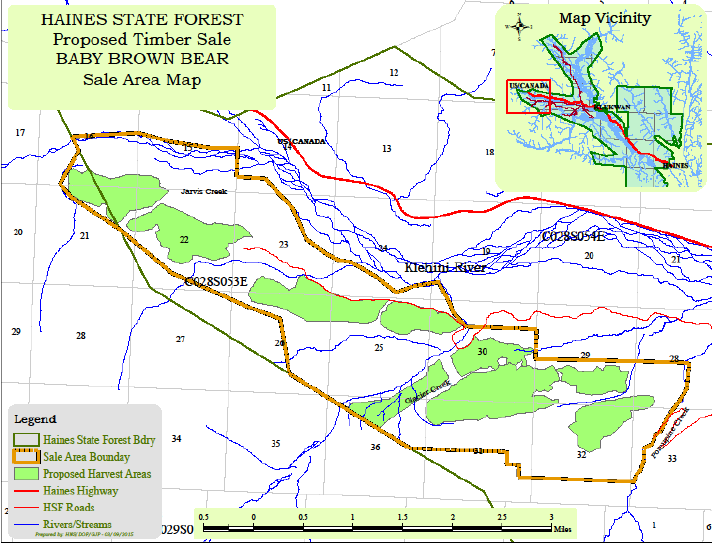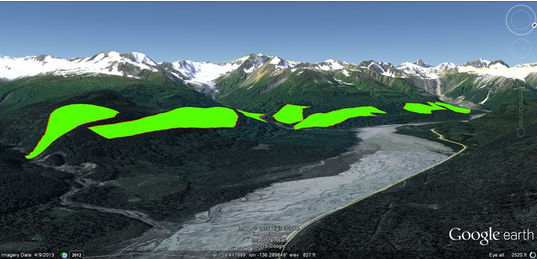 Earlier this month, the State Department of Natural Resources Commissioner denied an appeal from conservation groups over the proposed Baby Brown timber sale. The 855-acres of old-growth hemlock and spruce would be the largest area put up for sale in the Haines State Forest in decades.
Earlier this month, the State Department of Natural Resources Commissioner denied an appeal from conservation groups over the proposed Baby Brown timber sale. The 855-acres of old-growth hemlock and spruce would be the largest area put up for sale in the Haines State Forest in decades.
In April, Haines-based Lynn Canal Conservation was joined by Greenpeace and Cascadia Wildlands in appealing DNR’s final best interest finding for the Baby Brown timber sale.
“Here we are, still in the dark ages of forestry,” said LCC President Eric Holle. He sees the extensive sale area as geared toward an export market, not the local economy. “Cutting them down and exporting them so that there’s very little local processing and very little local benefit.”
DNR Commissioner Mark Myers repeatedly emphasizes throughout his 17-page response to the appeal DNR’s mandate of multi-use management. He says the department has a dual mission to conserve and develop natural resources.
“So all and all looking at that conserve versus develop balancing, I thought [the Division of Forestry] reached a reasonable balance,” Myers said in a phone interview. “But we’re not done yet, because the sales themselves haven’t been designed.”
Myers says the sale area is 855 acres, but that doesn’t mean that entire area will be harvested.
“This does not propose a sale, this opens an area for potential sales. And they may do small sales, they may do a larger sale, but it’s yet to be determined.”
The appellants argue that the size of the sale area puts it out of reach of local industry, and therefore it is not in the best interest of Alaskans. But Myers says it’s not an ‘either-or’ choice between Baby Brown and an ongoing small timber sale program in the Haines State Forest. He says even if all of the acres included in Baby Brown were harvested, there would still be plenty of available board feet for the small operations. Here’s another of the appellants’ concerns:
“Much of this sale will be visible from the Haines Highway and it would be one of the first things people would see when they come down from the Yukon coming down the highway,” Holle said. He thinks that would have an adverse impact on tourism and lower property values.

3-D view of proposed Baby Brown sale created by Haines resident Erik Stevens. (Credit: Erik Stevens)
The proposed harvest area is made up sections of forest between Jarvis and Porcupine Creeks. Myers says the harvests would happen in a way that minimized, but didn’t completely eliminate visual impact.
“Again, the devil’s in the details of the design of the sale[s] ultimately,” Myers said.
Myers says that there is no evidence logging detracts from tourism in recreation areas. Holle’s other major concern is potential impact to fisheries and other ‘old growth-dependent’ wildlife.
“I’m concerned as a scientist whether we have adequate buffers around streams,” Myer said. “Particularly, given the salmon need certain amount of shading, they need a certain amount of organic material, they need a certain type of habitat, were those buffer adequate to protect those values?”
Myers says when he asked that question of the division of forestry, he was satisfied with the protections that are in place. That includes 100-foot buffer zones around anadromous waters.
“I went in with a show-me attitude toward that issue and [DOF] provided me with a strong sense that they were going to provide those protections,” Myers said.
Local forester Greg Palmieri says as far as he knows, there are four potential buyers interested in portions of the Baby Brown sale. Two are from Southeast, but not Haines, and the others are from the Lower 48. But Holle still wonders about this sale that is so much larger than anything proposed in the Haines State Forest in decades.
“The obvious question is, why now?” Holle asked.
Myers says changes in federal forestry management are putting pressure on the state to offer more timber sales to maintain the timber industry.
“I do think that there’s a real concern that to maintain any sense of a viable industry [the state must] pick up some of the slack,” he said. He thinks the reason Haines hasn’t had larger sales in recent years is because the need wasn’t there. “But now those other sources are largely not available. So again, one of the challenges is how much of the slack does the state forest pick up and what are the consequences of that?”
Myers says he ultimately thinks the consequences of the Baby Brown sale won’t be negative for the local economy and environment, especially since he thinks it’s unlikely that all 855 acres will be clear cut in one big sale.
The appellants have a few weeks to decide whether they want to bring their appeal to Superior Court. Holle says that is a difficult decision for them.
“Non-profits like ourselves are a great disadvantage when going up against the state,” Holle said. “For one thing, we would risk going broke if we lost in court. So it would be a really big gamble.”
If the appellants don’t take that step, then the Baby Brown timber sale will move into the next phase of developing forest land use plans for the sale area. Those plans are subject to public review and appeal. The actual sale of timber comes after a final best interest finding and forest land use plans are adopted.








